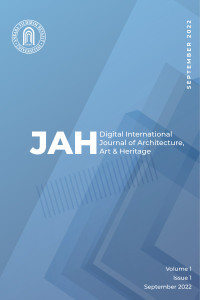Reading the Architectural Design Processes of University Campus Entrance Gates
Reading the Architectural Design Processes of University Campus Entrance Gates
___
- Akçay, F. Ç. (2018). Yarışma yöntemi ile elde edilen mimari projelerde işlevsel niteliğin artırılmasına yönelik bir model önerisi: Belediye hizmet binaları örneği, Doktora Tezi, Gazi Üniversitesi Fen Bilimleri Enstitüsü, Ankara.
- Akçay, F. Ç., Paç, D. G. (2021). Dolunay Parkı ve çevresine ait görseller.
- Akçay, F. Ç., Paç, D. G. (2021). Kullanıma sunulan kuleye ait görsel.
- Akçay, F. Ç. (2021). Ulusal mimari proje yarışmalarını kullanıcı – mekan ilişkisi üzerinden okumak. Online Journal of Art and Design, 9(3), s.211-233.
- Akçay, F. Ç., Paç, D. G. (2023). Erk Eksenli Ulusal Mimari Proje Yarışmaları: 70’li Yıllar Hükümet Konakları. F. Sönmez & S. Arslan Selçuk (Editörler), Anadolu’nun Yeniden İmarında Yarışma Projeleri: Yüzyılın Mimari Yarışmaları Üzerine (1930-1990) (ss. 268-283). İdealkent Yayınevi.
- Akçay, F. Ç., Sahil, S. (2021). Yarışma pratiğinden yansımalar. Yapı Dergisi, 470, 58-65
- Akpınar, İ. Y. & Aysev, E. (2011). Küreselleşen İstanbul’da bir sosyal aktör olarak mimarın rolü. Mimarlık / Dosya, Sayı 27, s.46-52.
- Arcan, E. F. & Evci, F. (1992). Mimari Tasarıma Yaklaşım. 2K Yayınevi, s. 49.
- Atay Kızıltaş, Z. M. (2016). Mimarlık yarışmalarının biyopolitika üzerinden sökümü, Yüksek Lisans Tezi, İstanbul Teknik Üniversitesi, İstanbul.
- Cengizkan, A. (2009). Türkiye’de mimar ve eser: Tanımsız bir ilişkinin dayanılmaz dağınıklığı. Mimarlık Dergisi, 349, s.19.
- Çalışlar, H., Kanıpak, Ö., Özyurt, E. (2017). Mimarlık ve mimar nasıl pazarlanır? Pazarlasak mı, yoksa pazarlamasak mı?, Arredamento Mimarlık Dergisi, 314, s.78-89.
- Çotusöken, B. (2004). Felsefe-Özne-Söylem. İnkılap Kitabevi, s.153.
- Farrelly, F. (2011). Mimarlığın temelleri. (N. Şık, Çev.). Literatür Kitabevi.
- Google earth (2023). Dolunay Parkı ile ilgili güncel hava fotoğrafı.
- İnceoğlu, N. (1977). Bina programlama sürecine analitik bir yaklaşım.Doçentlik Tezi, İstanbul Teknik Üniversitesi, İstanbul.
- İzgi, U. (1999). Mimarlıkta süreç kavramlar ilişkiler. Yapı Endüstri Merkezi Yayınları, İstanbul
- Karataş, B. (2014). Mimari ürünün görsel kimliğinin belirlenmesinde “mimar-işveren” etkilerinin incelenmesi. Yüksek lisans tezi, Yakın Doğu Üniversitesi Fen Bilimleri Enstitüsü, Lefkoşa.
- Kızılırmak, H. (2010). Mimari tasarım sürecinin betimlenmesi. Yüksek lisans tezi, Gazi Üniversitesi Fen Bilimleri Enstitüsü, Ankara, s.29.
- Lipstad, H. (1989). The experimental tradition. In H. Lipstad (Editor). The experimental tradition: Essays on competitions in architecture. New York: Princeton Architectural Press, s.9-19.
- Nemati, B. (2013). Improving Maslow’s hierarchy of needs: New approach to needshierarchy. Applied Mathematics in Engineering, Management and Technology, 1(1), s.1-16.
- Onur, B. & Özeren, Ö. (2020). 21. yüzyıl Türkiye’sinde tarihsici mimarlığın izi: Üniversite giriş (nizamiye) kapıları. Euroasia Journal Of Social Sciences Humanities, 7(3), s. 44-55.
- Özen Yavuz A., Akçay F. Ç. (2012). Development of an approach for producing architectural form in design education. Procedia-Social and Behavioral Sciences, 51, s.222-227.
- Özen Yavuz A., İlerisoy, Z. Y., Akçay F. Ç. (2012). Gazi Üniversitesi Merkez Kampüs A Girişi Kapı Tasarımı ve Yakın Çevre Düzenlemesi’ne ilişkin genel bilgiler, vaziyet planı, kat planları ve görseller. Ankara.
- Özgüner, A. (2000). Hadid'le konuşma. Çağdaş Dünya Mimarları Dizisi-9: Zaha Hadid Çağdaş Dünya Mimarları Dizisi. İstanbul: Boyut Yayın Grubu, s.48-67.
- Palmer, R. E. (2008). Hermenötik (İ Görener, Çev.). Ağaç Kitabevi Yayınları, s.40.
- Pamir, H. (2001). Tasarım süreci ve alternatif biçimlendirme stratejileri. XXI Mimarlık Kültürü Dergisi, 9, s. 22.
- Preiser, W. F. E. (1991). Design innovation and the challenge of change. In W. F. E. Preiser, J. Vischer and E. White (Eds.). Design intervation: Toward a more humane architecture (First Edition). New York: Van Nostrand Reinhold, s.335-349.
- Sanoff, H. (1977). Methods of architectural programming (First Edition). Stroudsburg: Dowden Hutchinson & Ross.
- Şen, F. G. (2006). Müşteri isteklerindeki değişikliklerin proje nitelikleri üzerindeki etkileri. Yüksek Lisans Tezi. İstanbul Teknik Üniversitesi Fen Bilimleri Enstitüsü.
- Şentürer, A. (2004). Estetik bugün (ve Türkiye): Kötü taklit, gerçeklik, yenilik. Etik-estetik (1. Baskı). Yapı Endüstri Merkezi Yayınları, s.174-191.
- Uluoğlu, B. (2004). Mimarlık bilgisinin çifte kimliği ve kavramsallaştırılış biçimi üzerine. A. Şentürer, Ş. Ural ve A. Atasoy (Editörler). Mimarlık ve felsefe. Yapı Endüstri Merkezi Yayınları, s.52-67.
- Ural, Ş. (2004). Mimari bir objenin felsefi açıdan yorumu. A. Şentürer, Ş. Ural ve A. Atasoy (Editörler). Mimarlık ve felsefe. Birinci Baskı. İstanbul. Yapı Endüstri Merkezi Yayınları, s.24-39.
- Yıldırım, B. (2022). Kırıkkale Üniversitesi Kampüsü Giriş Kapısı Tasarımı’na ilişkin genel bilgiler ve görseller. Kırıkkale.
- URL-1: Gazi Üniversitesi Ana Kapı. https://www.cografya.gen.tr/gazi/gazi-universitesi.htm (Erişim Tarihi: 01.02.2021).
- URL-2: 2017 yılında kaldırılan Kırıkkale Üniversitesi Kampüsü Giriş Kapısı. http://www.mansetgazetesi.net/haber/- kampus-giris-kapisi-yenileniyor-9657.html (Erişim tarihi: 05.02.2023).
- URL-3: Sivas Cumhuriyet Üniversitesi tarafından talep edilen giriş kapıları ile ilgili açıklamalar. http://www.cumhuriyet.edu.tr/habergoster.php?haberid=5892 (Erişim Tarihi: 01.02.2023)
- URL-4: Ege Üniversitesi tarafından talep edilen giriş kapısı ile ilgili açıklamalar. https://egeajans.ege.edu.tr/?p=2786 (Erişim tarihi: 01.02.2023)
- URL-5: Sivas Cumhuriyet Üniversitesi Kampüsü Batı Giriş Kapısı; Kaldırılan Giriş Kapısı. https://expatguideturkey.com/study-in-cumhuriyet-university/ (Erişim Tarihi: 10.02.2023).
- URL-6: Sivas Cumhuriyet Üniversitesi Kampüsü Batı Giriş Kapısı; Mevcut Giriş Kapısı. http://bizimsivas.com.tr/haber/suse-degil-egitime-yonelelim-14975.html ( Erişim Tarihi: 10.02.2023). URL-7: Ege Üniversitesi Merkez Kampüs Ana Giriş Kapısı: Kaldırılan Giriş Kapısı. http://www.ege.edu.tr/files/slider/egeg.jpg (Erişim Tarihi: 10.02.2023).
- URL-8: Ege Üniversitesi Merkez Kampüs Ana Giriş Kapısı: Mevcut Giriş Kapısı.https://ege.edu.tr/a3332/ege_universitesi__turkiye%E2%80%99nin_en_iyi_6%E2%80%99nci_universitesi.html (Erişim Tarihi: 10.02.2023).
- Başlangıç: 2022
- Yayıncı: Ankara Yıldırım Beyazıt Üniversitesi
Architectural Features of the Agora(Bazaar) of the Ancient City of Anastiopolis (Dara)
Lale KARATAŞ, Murat DAL, Devrim Hasan MENTEŞE
Discourses/Actions: The Nation's Library
Çiğdem YILDIRIM, Fatih Çağrı AKÇAY
Adıyaman University Campus Plan: Design, Development and Snapshot after Earthquake
Edirne/Keşan Çamlıca (Grabuna) Köyü’nde Kırsal Mimari ve Koruma Sorunları
Tahsin Aykut ÇETİNMAKAS, Tülay CANITEZ
Çankırı, Kurşunlu, Çarşı Han Yapısı Belgeleme ve Restitüsyon Analizi
Ammar İBRAHİMGİL, Halime Sertaç AKYOL
Sistem İlişkileri Açısından Sürdürülebilir Sağlıklı Yapı Üretimi Kuramsal Modeli
Reading the Architectural Design Processes of University Campus Entrance Gates
Calvino’nun Görünmez Kentlerine Farklı Bir Bakış: Görünür Hale Getirerek Dijitale Taşımak
Demolished Public Buildings: The Discontinuity of National Competition Memory
